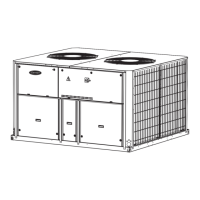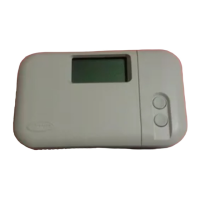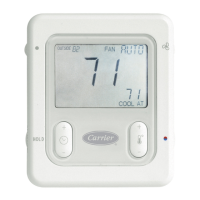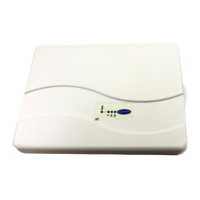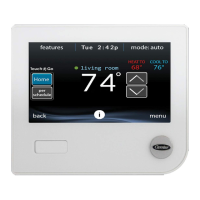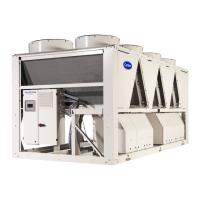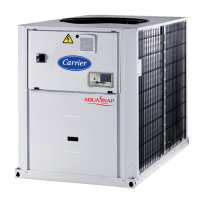Do you have a question about the Carrier PIC 5+ and is the answer not in the manual?
Safety precautions and requirements for installing the chiller.
Safety guidelines for performing maintenance on the chiller.
Procedures for operating checks and handling relief valves.
Information on equipment and components designed for pressure operation.
Safety precautions specific to performing repairs on the unit.
Defines the allowable operating and storage temperature limits for the chiller.
Glossary of common abbreviations used in the manual.
Details on available technical documentation like wiring diagrams and PID.
Information regarding CE marking and safety accessory classification.
Overview of the 19DV chiller's components and systems.
Location of the chiller's information plate.
Identification and description of the main system components.
How to identify the chiller model and its components.
Explanation of the chiller's refrigeration cycle operation.
Description of the refrigerant system used for compressor lubrication.
Overview of the installation process and responsibilities.
Procedures for receiving and inspecting the chiller upon delivery.
Detailed steps for inspecting the delivered machine for damage or missing parts.
Steps to confirm the unit received matches the order via nameplate data.
Checks and requirements before starting the chiller's electrical installation.
Instructions for protecting the machine from construction dirt and moisture.
Guidelines for selecting a suitable indoor environment for chiller installation.
Procedures for rigging the chiller as a complete assembly or disassembled.
Instructions and warnings for lifting the entire chiller machine.
Guidance on installing machine supports, including isolation and leveling.
Details on installing standard isolation using support plates and flex pads.
Procedures for installing leveling accessories and ensuring the machine is level.
Information on installing spring isolation assemblies for vibration and noise reduction.
Instructions for connecting water, vent, and purge piping to the heat exchangers.
Guidance on installing water piping using job data and piping drawings.
Procedures for installing vent piping for relief devices, ensuring outdoor discharge.
Connection of the purge discharge to the safety valve vent line.
Instructions for making electrical connections, following diagrams and codes.
Details on wiring control inputs, including safety switches and remote contacts.
Details on wiring control outputs, including alarm relays and status signals.
Description of the SRMCR safety loop for overpressure protection.
Instructions for wiring the Variable Frequency Drive (VFD) with shielded cable.
Guidance on wiring the CCN communication bus for network integration.
How to initiate start-up and stop sequences using the HMI.
Explanation of the refrigerant lubrication system's operation and control.
Procedures for safely shutting down the chiller, including normal and fault conditions.
Comprehensive list of checks required before starting the system.
Verification of installation drawings, diagrams, and documentation.
List of tools and equipment needed for start-up checks.
Procedure for removing shipping materials from the unit and panels.
Checking the status of lubrication and purge circuit valves.
Ensuring all gasketed joints are properly tightened to prevent leaks.
Procedures for leak testing the chiller, including using tracer gas.
Leak test procedure for chillers with nitrogen holding charge.
Recommended use of refrigerant tracers for leak detection procedures.
Detailed procedure for leak testing the chiller, including pressure and temperature points.
Performing a standing vacuum test to check for leaks and vacuum integrity.
Procedures for dehydrating the chiller to remove moisture.
Checking water piping for correct flow direction and system compatibility.
Verifying relief devices are piped correctly and set appropriately.
Inspecting all wiring for conformance to diagrams and codes.
Procedure for troubleshooting ground faults using insulation resistance tests.
Verifying the proper operation of the purge compressor.
Final checks on the installation, wiring, and power supply.
Verifying the proper functioning of the refrigerant lubrication system.
Step-by-step guide for charging the chiller with refrigerant.
Steps for configuring chiller software parameters and set points.
How to access and input design set points via the HMI.
Setting up the occupied time schedule for chiller operation.
Configuring service parameters and accessing different user levels.
Verifying VFD values and equipment configuration against job data.
Performing automated control tests for actuators and safeties.
Calibrating pressure transducers and waterside flow devices for accuracy.
Pre-start checks and verification of chiller, VFD, and pumps.
Procedure for checking and verifying correct motor rotation.
Checking the refrigerant lubrication pressure and filter status.
Setting up an override to prevent accidental start-up during service.
Verifying chiller operating parameters like temperature, pressure, and flow.
Ensuring the operator understands chiller parts, functions, and procedures.
Responsibilities and tasks for the chiller operator.
Step-by-step guide for starting the chiller system.
Monitoring and checking system parameters during operation.
Procedures for safely stopping the chiller, both manually and automatically.
Preparations required after a limited shutdown period.
Steps for preparing the chiller for extended shutdown, including draining.
Checks and procedures after the chiller has been shut down for an extended period.
Considerations and procedures for operating the chiller in cold weather conditions.
How to manually operate guide vanes for control or emergency purposes.
Using a log sheet for routine inspection, maintenance, and performance tracking.
Requirements and procedures for chillers that are idle for short or long periods.
Description of the Auto and Manual modes for the purge system.
Process of pumping out non-condensable gases from the purge tank.
Explanation of the carbon filter's function and regeneration process.
General guidelines and checks for maintaining the chiller during its operating life.
Correct procedures and precautions for soldering and welding operations.
Information about the HFO R-1233zd(E) refrigerant used in the chiller.
Procedures for adding refrigerant, including safety precautions.
How to adjust refrigerant charge for optimal chiller performance.
Methods and procedures for detecting and repairing refrigerant leaks.
Using refrigerant tracers for leak detection procedures.
Alternative leak testing methods using nitrogen and soap bubble solution.
Procedure for pressurizing with dry nitrogen for leak testing.
Recommended maximum allowable leak rates for the refrigerant system.
Post-service testing requirements, including leak testing.
Steps for repairing leaks, retesting, and performing a vacuum test.
Procedure for checking and adjusting guide vane positions.
Fine-tuning the refrigerant charge for optimal chiller performance.
Routine checks to be performed weekly on the chiller system.
Verifying the refrigerant lubrication system, including sight glasses.
Checking for leaks indicated by purge operation and reviewing run times.
Establishing a regular maintenance schedule based on chiller requirements.
Tracking and resetting service hours and pumpout counts.
Cleaning and tightening connections in the control cabinets.
Procedures for inspecting the purge system to protect against non-condensables.
Annual inspection and cleaning of the purge unit's condenser coil and parts.
Procedures for replacing refrigerant lubrication, motor cooling, and bearing filters.
When to replace the purge carbon filter.
Step-by-step guide for replacing the refrigerant pump.
Inspecting the condenser and economizer float systems for proper function.
Inspecting safety relief valves and their associated piping for corrosion or leaks.
Performing periodic checks on the SRMCR safety loop components.
Importance of lubrication, vibration analysis, and bearing inspection.
Inspecting cooler and condenser tubes and flow devices for scale or corrosion.
Identifying and repairing water leaks within the chiller system.
Importance of water treatment to prevent corrosion and scaling.
Safety precautions and procedures for inspecting or removing power cabinet components.
Introduction to the PIC 5+ system's troubleshooting features.
How to interpret status messages and alarms on the PIC 5+ TOUCH SCREEN.
Procedures for checking NTC thermistor temperature sensors.
Measuring sensor resistance to verify temperature readings.
Measuring voltage drop across energized sensors for accuracy checks.
Calibrating temperature sensors and checking their accuracy.
Procedures for checking and calibrating pressure transducers.
Recalibrating pressure transducers for operation at high altitudes.
Using the Quick Test feature to test chiller status and components.
Calibrating IGVs and EC valves using the Quick Calibration menu.
Using Pumpdown/Lockout to prevent compressor start-up under specific conditions.
Safety precautions and requirements for installing the chiller.
Safety guidelines for performing maintenance on the chiller.
Procedures for operating checks and handling relief valves.
Information on equipment and components designed for pressure operation.
Safety precautions specific to performing repairs on the unit.
Defines the allowable operating and storage temperature limits for the chiller.
Glossary of common abbreviations used in the manual.
Details on available technical documentation like wiring diagrams and PID.
Information regarding CE marking and safety accessory classification.
Overview of the 19DV chiller's components and systems.
Location of the chiller's information plate.
Identification and description of the main system components.
How to identify the chiller model and its components.
Explanation of the chiller's refrigeration cycle operation.
Description of the refrigerant system used for compressor lubrication.
Overview of the installation process and responsibilities.
Procedures for receiving and inspecting the chiller upon delivery.
Detailed steps for inspecting the delivered machine for damage or missing parts.
Steps to confirm the unit received matches the order via nameplate data.
Checks and requirements before starting the chiller's electrical installation.
Instructions for protecting the machine from construction dirt and moisture.
Guidelines for selecting a suitable indoor environment for chiller installation.
Procedures for rigging the chiller as a complete assembly or disassembled.
Instructions and warnings for lifting the entire chiller machine.
Guidance on installing machine supports, including isolation and leveling.
Details on installing standard isolation using support plates and flex pads.
Procedures for installing leveling accessories and ensuring the machine is level.
Information on installing spring isolation assemblies for vibration and noise reduction.
Instructions for connecting water, vent, and purge piping to the heat exchangers.
Guidance on installing water piping using job data and piping drawings.
Procedures for installing vent piping for relief devices, ensuring outdoor discharge.
Connection of the purge discharge to the safety valve vent line.
Instructions for making electrical connections, following diagrams and codes.
Details on wiring control inputs, including safety switches and remote contacts.
Details on wiring control outputs, including alarm relays and status signals.
Description of the SRMCR safety loop for overpressure protection.
Instructions for wiring the Variable Frequency Drive (VFD) with shielded cable.
Guidance on wiring the CCN communication bus for network integration.
How to initiate start-up and stop sequences using the HMI.
Explanation of the refrigerant lubrication system's operation and control.
Procedures for safely shutting down the chiller, including normal and fault conditions.
Comprehensive list of checks required before starting the system.
Verification of installation drawings, diagrams, and documentation.
List of tools and equipment needed for start-up checks.
Procedure for removing shipping materials from the unit and panels.
Checking the status of lubrication and purge circuit valves.
Ensuring all gasketed joints are properly tightened to prevent leaks.
Procedures for leak testing the chiller, including using tracer gas.
Leak test procedure for chillers with nitrogen holding charge.
Recommended use of refrigerant tracers for leak detection procedures.
Detailed procedure for leak testing the chiller, including pressure and temperature points.
Performing a standing vacuum test to check for leaks and vacuum integrity.
Procedures for dehydrating the chiller to remove moisture.
Checking water piping for correct flow direction and system compatibility.
Verifying relief devices are piped correctly and set appropriately.
Inspecting all wiring for conformance to diagrams and codes.
Procedure for troubleshooting ground faults using insulation resistance tests.
Verifying the proper operation of the purge compressor.
Final checks on the installation, wiring, and power supply.
Verifying the proper functioning of the refrigerant lubrication system.
Step-by-step guide for charging the chiller with refrigerant.
Steps for configuring chiller software parameters and set points.
How to access and input design set points via the HMI.
Setting up the occupied time schedule for chiller operation.
Configuring service parameters and accessing different user levels.
Verifying VFD values and equipment configuration against job data.
Performing automated control tests for actuators and safeties.
Calibrating pressure transducers and waterside flow devices for accuracy.
Pre-start checks and verification of chiller, VFD, and pumps.
Procedure for checking and verifying correct motor rotation.
Checking the refrigerant lubrication pressure and filter status.
Setting up an override to prevent accidental start-up during service.
Verifying chiller operating parameters like temperature, pressure, and flow.
Ensuring the operator understands chiller parts, functions, and procedures.
Responsibilities and tasks for the chiller operator.
Step-by-step guide for starting the chiller system.
Monitoring and checking system parameters during operation.
Procedures for safely stopping the chiller, both manually and automatically.
Preparations required after a limited shutdown period.
Steps for preparing the chiller for extended shutdown, including draining.
Checks and procedures after the chiller has been shut down for an extended period.
Considerations and procedures for operating the chiller in cold weather conditions.
How to manually operate guide vanes for control or emergency purposes.
Using a log sheet for routine inspection, maintenance, and performance tracking.
Requirements and procedures for chillers that are idle for short or long periods.
Description of the Auto and Manual modes for the purge system.
Process of pumping out non-condensable gases from the purge tank.
Explanation of the carbon filter's function and regeneration process.
General guidelines and checks for maintaining the chiller during its operating life.
Correct procedures and precautions for soldering and welding operations.
Information about the HFO R-1233zd(E) refrigerant used in the chiller.
Procedures for adding refrigerant, including safety precautions.
How to adjust refrigerant charge for optimal chiller performance.
Methods and procedures for detecting and repairing refrigerant leaks.
Using refrigerant tracers for leak detection procedures.
Alternative leak testing methods using nitrogen and soap bubble solution.
Procedure for pressurizing with dry nitrogen for leak testing.
Recommended maximum allowable leak rates for the refrigerant system.
Post-service testing requirements, including leak testing.
Steps for repairing leaks, retesting, and performing a vacuum test.
Procedure for checking and adjusting guide vane positions.
Fine-tuning the refrigerant charge for optimal chiller performance.
Routine checks to be performed weekly on the chiller system.
Verifying the refrigerant lubrication system, including sight glasses.
Checking for leaks indicated by purge operation and reviewing run times.
Establishing a regular maintenance schedule based on chiller requirements.
Tracking and resetting service hours and pumpout counts.
Cleaning and tightening connections in the control cabinets.
Procedures for inspecting the purge system to protect against non-condensables.
Annual inspection and cleaning of the purge unit's condenser coil and parts.
Procedures for replacing refrigerant lubrication, motor cooling, and bearing filters.
When to replace the purge carbon filter.
Step-by-step guide for replacing the refrigerant pump.
Inspecting the condenser and economizer float systems for proper function.
Inspecting safety relief valves and their associated piping for corrosion or leaks.
Performing periodic checks on the SRMCR safety loop components.
Importance of lubrication, vibration analysis, and bearing inspection.
Inspecting cooler and condenser tubes and flow devices for scale or corrosion.
Identifying and repairing water leaks within the chiller system.
Importance of water treatment to prevent corrosion and scaling.
Safety precautions and procedures for inspecting or removing power cabinet components.
Introduction to the PIC 5+ system's troubleshooting features.
How to interpret status messages and alarms on the PIC 5+ TOUCH SCREEN.
Procedures for checking NTC thermistor temperature sensors.
Measuring sensor resistance to verify temperature readings.
Measuring voltage drop across energized sensors for accuracy checks.
Calibrating temperature sensors and checking their accuracy.
Procedures for checking and calibrating pressure transducers.
Recalibrating pressure transducers for operation at high altitudes.
Using the Quick Test feature to test chiller status and components.
Calibrating IGVs and EC valves using the Quick Calibration menu.
Using Pumpdown/Lockout to prevent compressor start-up under specific conditions.
| Input Voltage Range | 24 VDC |
|---|---|
| Relative Humidity Range | 5% to 95% non-condensing |
| Number of Universal Inputs | 8 |
| Enclosure Rating | IP20 |
| Communication Ports | RS-485 |
| Storage Temperature Range | -40°C to +85°C |
| Communication Protocol | Modbus RTU |
